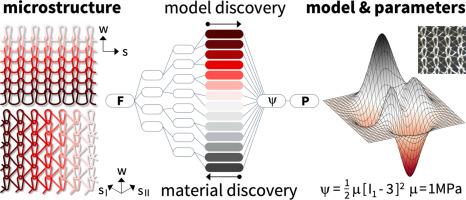Automated model discovery for textile structures: The unique mechanical signature of warp knitted fabrics
IF 9.4
1区 医学
Q1 ENGINEERING, BIOMEDICAL
引用次数: 0
Abstract
Textile fabrics have unique mechanical properties, which make them ideal candidates for many engineering and medical applications: They are initially flexible, nonlinearly stiffening, and ultra-anisotropic. Various studies have characterized the response of textile structures to mechanical loading; yet, our understanding of their exceptional properties and functions remains incomplete. Here we integrate biaxial testing and constitutive neural networks to automatically discover the best model and parameters to characterize warp knitted polypropylene fabrics. We use experiments from different mounting orientations, and discover interpretable anisotropic models that perform well during both training and testing. Our study shows that constitutive models for warp knitted fabrics are highly sensitive to an accurate representation of the textile microstructure, and that models with three microstructural directions outperform classical orthotropic models with only two in-plane directions. Strikingly, out of 216,384 possible combinations of terms, we consistently discover models with two exponential linear fourth invariant terms that inherently capture the initial flexibility of the virgin mesh and the pronounced nonlinear stiffening as the loops of the mesh tighten. We anticipate that the tools we have developed and prototyped here will generalize naturally to other textile fabrics–woven or knitted, weft knit or warp knit, polymeric or metallic–and, ultimately, will enable the robust discovery of anisotropic constitutive models for a wide variety of textile structures. Beyond discovering constitutive models, we envision to exploit automated model discovery as a novel strategy for the generative material design of wearable devices, stretchable electronics, and smart fabrics, as programmable textile metamaterials with tunable properties and functions. Our source code, data, and examples are available at https://github.com/LivingMatterLab/CANN.
Statement of significance
Textile structures are rapidly gaining popularity in many biomedical applications including tissue engineering, wound healing, and surgical repair. A precise understanding of their unique mechanical properties is critical to tailor them to their specific functions. Here we integrate mechanical testing and machine learning to automatically discover the best models for knitted polypropylene fabrics. We show that warp knitted fabrics possess a complex symmetry with three distinct microstructural directions. Along these, the behavior is dominated by an exponential linear term that characterize the initial flexibility of the virgin mesh and the nonlinear stiffening as the loops of the fabric tighten. We expect that our technology will generalize naturally to other fabrics and enable the robust discovery of complex anisotropic models for a wide variety of textile structures.

自动发现纺织结构模型:经编织物的独特机械特征
纺织织物具有独特的机械特性,是许多工程和医疗应用的理想选择:它们最初具有柔韧性、非线性刚度和超各向异性。各种研究都描述了织物结构对机械负载的响应;然而,我们对其特殊属性和功能的了解仍不全面。在此,我们整合了双轴测试和构成神经网络,以自动发现表征经编聚丙烯织物的最佳模型和参数。我们利用不同安装方向的实验,发现了可解释的各向异性模型,这些模型在训练和测试过程中均表现良好。我们的研究表明,经编面料的构成模型对纺织品微观结构的准确表述非常敏感,具有三个微观结构方向的模型优于只有两个平面方向的经典正交模型。引人注目的是,在 214=16,384 个可能的项组合中,我们不断发现具有两个指数线性第四不变量项的模型,这些项从本质上捕捉到了原始网格的初始柔性以及随着网格圈收紧而产生的明显非线性刚度。我们预计,我们在此开发和原型设计的工具将自然而然地推广到其他纺织面料--梭织或针织、纬编或经编、聚合物或金属--并最终能够为各种纺织结构稳健地发现各向异性的构成模型。除了发现结构模型外,我们还设想利用自动发现模型来进行可穿戴设备、可拉伸电子设备和智能织物的生成材料设计,将其作为具有可调特性和功能的可编程纺织超材料。我们的源代码、数据和示例可在 https://github.com/LivingMatterLab/CANN 上获取。意义说明:纺织品结构在许多生物医学应用中迅速普及,包括组织工程、伤口愈合和手术修复。准确了解其独特的机械特性对于使其适应特定功能至关重要。在这里,我们将机械测试与机器学习相结合,自动发现聚丙烯针织物的最佳模型。我们的研究表明,经编织物具有复杂的对称性,有三个不同的微观结构方向。沿着这三个方向,其行为主要由指数线性项和非线性刚度项决定,指数线性项描述了原始网格的初始柔性,而非线性刚度项则描述了织物线圈收紧时的柔性。我们希望我们的技术能自然地推广到其他织物上,并能为各种纺织结构稳健地发现复杂的各向异性模型。
本文章由计算机程序翻译,如有差异,请以英文原文为准。
求助全文
约1分钟内获得全文
求助全文
来源期刊

Acta Biomaterialia
工程技术-材料科学:生物材料
CiteScore
16.80
自引率
3.10%
发文量
776
审稿时长
30 days
期刊介绍:
Acta Biomaterialia is a monthly peer-reviewed scientific journal published by Elsevier. The journal was established in January 2005. The editor-in-chief is W.R. Wagner (University of Pittsburgh). The journal covers research in biomaterials science, including the interrelationship of biomaterial structure and function from macroscale to nanoscale. Topical coverage includes biomedical and biocompatible materials.
 求助内容:
求助内容: 应助结果提醒方式:
应助结果提醒方式:


